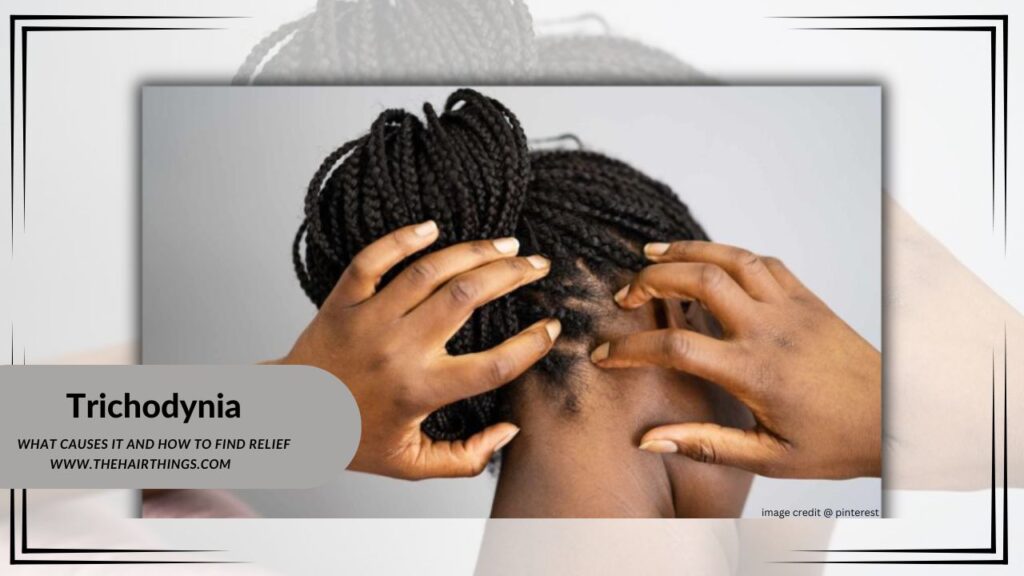“Hair pain syndrome,” also known as trichodynia, is a disorder that causes pain or discomfort in the scalp but does not show any outward symptoms of inflammation or irritation. Trichodonia, although common, is still a disorder that is largely misdiagnosed and poorly understood. Achieving management of this severe illness requires an understanding of its causes and the discovery of efficient alleviation techniques.
Causes of Trichodynia:
There are many potential causes of trichodynia, thus identifying one is difficult. Still, a few typical triggers are as follows:
- Scalp Sensitivity: Even small stimuli like brushing or style can cause trichodynia in people with high scalp sensitivity.
- Traction Alopecia: Tight hairstyles like braids or ponytails can produce prolonged tension on the hair follicles, which can result in traction alopecia and consequent scalp pain.
- Conditions of the Scalp: By producing itching, irritation, and inflammation, some conditions of the scalp, such as scalp psoriasis or seborrheic dermatitis, may aggravate and cause trichodynia.
- Stress and Anxiety: Trichotillomania has been related to psychological variables including stress and anxiety, which exacerbate symptoms and make pain management more difficult.
Trichodynia Treatment:
Many techniques can help reduce symptoms and enhance general scalp health, even if trichodynia can be upsetting and disruptive:
- Adopting a moderate hair care regimen will help to lessen pain and irritation of the scalp. Don’t overbrush or overstyle; instead, use gentle, sulfate-free shampoos.
- Regular scalp massages can provide relief from the symptoms of trichodynia by promoting relaxation, enhancing blood circulation, and easing tension.
- Practices for Stress Management: Including practices for stress management in your daily routine, such as yoga, deep breathing exercises, or meditation, can assist lessen psychological pressures that lead to trichodynia.
- Topical respite: For some people, topical therapies with substances like menthol, capsaicin, or lidocaine may be helpful in providing momentary respite from scalp pain.
- See a Dermatologist: It is advised to seek the advice of a dermatologist if self-care measures are not effective in treating trichodynia or if it gets worse. A dermatologist can provide a thorough examination, identify any underlying scalp issues, and suggest suitable, individually-tailored treatment choices.
Conclusion:
Those who have trichodynia face a distinct set of difficulties that influence their general well-being and quality of life. People can manage trichodynia and regain comfort and confidence in the condition of their scalp by being aware of the possible reasons and investigating practical relief plans. It is imperative to seek professional help and implement a holistic approach to care in order to properly navigate this difficult ailment.
FAQs:
What are trichodynia’s typical causes?
Factors including traction alopecia, scalp disorders like seborrheic dermatitis, psychological stressors like anxiety, and scalp sensitivity can all cause trichomonia.
How can I get rid of the symptoms of trichodynia?
Strategies include implementing a gentle hair care routine, massaging the scalp, successfully managing stress, applying topical therapies, and seeking individual advice from a dermatologist can all help alleviate the symptoms of trichodynia.
Is trichodynia frequently occurring?
Despite being underdiagnosed frequently, trichomonia is a relatively common condition that can afflict people of all ages and genders.
Which moderate hair care techniques can help relieve trichodynia?
Choosing scalp-friendly hair products, reducing brushing and styling, staying away from tight hairstyles, and using sulfate-free shampoos are examples of gentle hair care techniques.
When should I consult a doctor if I have trichodynia?
It’s best to see a dermatologist for a thorough assessment and customized treatment plan if self-care approaches don’t alleviate or exacerbate trichodynia symptoms.








